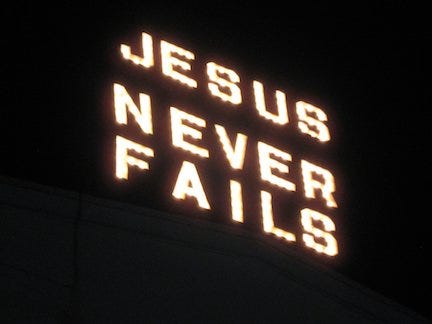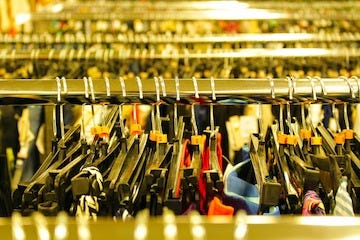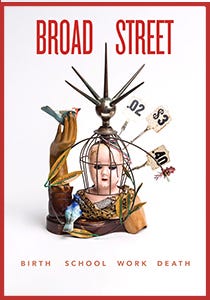Identity among the thrift-store racks.
“Some days this room seems like a testament to folly and wastefulness. Other days, this day, it speaks of people just trying to live their lives.”

–
“Passing Through”
I was making my rounds the other day, practicing the heart-gladdening, soul-soothing, work-avoiding art of thrift-shopping.
I’ve thrifted almost longer than I can remember: In college, on Saturday mornings, biking up to 82nd Avenue with my friend Susan to check for moth holes in the Pendletons. Between classes in high school, scoring seed-bead cashmere cardigans for twenty-five cents in the school auxiliary run by parents, which is to say, mothers. Where was I when President Kennedy was shot? Lankenau Hospital Hamper Shop, all the women crowding around a transistor radio, weeping. I was four.
My mother’s Great Depression childhood is often credited for her three children’s privileging used over new, but our father also transmitted to us an appreciation for squeezing out every last drop of use. He grew up in rural Georgia, where access to goods was limited by logistics, then limited further still by the strictures of Jim Crow. If you could avoid the scrutiny and degradation that might occur over any transaction, you did. So my sisters and I don’t throw things away easily. What we can’t salvage by cleaning or recalibrating, we will mend or repair or re-home. If, at a thrift store, we find items that are charming and inexpensive and operable, it is commonly understood as having hit the jackpot.
This family folkway is all well and good, except that as someone who works flexible hours and mostly from home, I’m too available for spur-of-the-moment expeditions. Consequently, I can claim firsthand knowledge of every secondhand retailer within a fifteen-mile range of my house. I know which stores hold half-price days and which days of the week those are, which cashiers will sell merchandise that has lost its price tag, despite signage taped to the register clearly stating otherwise.
The line between actually useful and potentially useful has diminished with time, both categories filling my shelves and closets and basement. Will there ever be a need for that Medusan tangle of miniature springs? The vintage sconces and English cookie tins? The crated yarn now lining the wall of a spare room, all those miscellaneous skeins evidencing other people’s abandoned aspirations and miscalculated yardage? Sometimes family members come in search of this or that, often finding it. They call my house Li-Mart.
More difficult to unearth is a bottom line: What have I saved? What have I lost? An hour here and there, a dollar here and there — squared and cubed, it adds up. Once in a while, I get in the car only to turn around mid-route; mostly, the pull is a riptide. Abstinence has always felt untenable, but what about consolidation? I recently came up with a plan to limit scavenging to once a month. Its genius, I believed, was that in that single outing I would permit myself to hit as many spots as I wanted. Restraint, with splurge rising.
My thrifting-in-moderation scheme launched on a Saturday. Salvation Army first, followed by Bargain Thrift, and then to complete the loop, Whosoever Gospel Mission & Rescue Home Thrift Store. My older sister first took me to Whosoever after I moved back to Philadelphia. At that point, twenty-some years ago, I had an empty house to fill and an old Corolla wagon with a surprising amount of cargo space.
***
I drive a hatchback now, which I parked a few steps from Whosoever’s front door on that third and final stop. There’s always a space out front. The Whosoever mothership fronts onto Chelten Avenue, a major thoroughfare, but commerce has drizzled out by the time you get to the mission, where the closest competition is the gas station across the street, and its customers never park. Whosoever’s complex takes up a good amount of real estate: it’s a lumpy, squat compilation, a combined row of five nineteenth-century storefronts that make up the shop, which then abuts a stone-faced dormitory, and the sprawl of it all is topped by a sign on the roof promising in light-bulb letters, “JESUS NEVER FAILS.”
I plucked coins from the ashtray, loaded thirty minutes onto the meter, and headed to the shop’s entrance, a blue steel door whose small window is occluded by notices and grime. That door opens into the largest of the showrooms, a repository of clothes, shoes, linens, and the checkout counter, behind which reside the more valuable, more desirable, more breakable items. Also the knives. To the right is the furniture room, a reliable source for oversized table lamps and adjustable-height toilet seats. To the left is everything else. Romance novels and flatware, toys and TVs, golf clubs and plug-in desktop fountains. Electric windshield de-icers.
Some days this third room seems like a testament to folly and wastefulness. So much plastic. So many contraptions destined to break and gather dust and end up in landfills. Other days, this day, it speaks of people just trying to live their lives, seeking comfort and order and pleasure that will not cost more than they can afford.
As in many faith-based secondhand stores, the background music played is also faith-based. My fellow customers hum or sing along as they peruse the church-worthy dresses and taped-shut puzzles. Over at the Salvie, satellite radio fills the air with faith-affirming DJ banter and Contemporary Christian tunes, but at Whosoever, classic gospel ebbs and flows above our heads.
The store is staffed by men from the mission in various stages of recovery and redemption, present in numbers often equal to the number of customers. Some men stand at their posts with still-vacant eyes, responsive to greetings but never initiating. Others seem to have climbed back into the world, and among these men, who are eventually entrusted with management positions or the cash register or the donations door, there is generally a buoyancy and helpfulness — much commiserating about the weather and cracking wise at no one’s expense.
Usually, I’m the only white-faced person in the place. Once in a while, middle-aged white-faced men come to paw through the vinyl bins, or flocks of white-faced hipsters flit through on the hunt for irony and vintage. Once in a great while, the man with vacant eyes who is carting furniture or straightening the electronics shelves will be white-faced, too.
I prefer those times when no white customers are present. Maybe because my father is twelve years gone now, and his people live so far away; it’s rare these days for me to be among groups of black people where I am accorded full membership, where I am known as black despite my appearance. I come from generations of melanin drain on one side and a Euro/Brit stew on the other: the optics are misleading, my visible credentials suspect — not obvious, not automatic. But at Whosoever, even though I’m among strangers, I get a little taste of that side of my family. A little sumpin-sumpin. I may stand out for other reasons — I don’t take the free food or pay in change counted out from a snap-clasp coin purse — but mostly no one pays me any mind, an indifference that is itself a gift.
I can’t know what people think when they pass me in an aisle or when they ask, because I’m standing right there, if the coat they’re trying on seems too tight across the shoulders. They can’t know that when I look at them I find comfort, find a reflection that isn’t held by any mirror.
***
The three showrooms didn’t take long to get through: the parking meter was in no danger of running out. In the Everything Else room, I waded through cultural flotsam and As-Seen-On-TV jetsam, flower-shop vases and half-finished needlepoints and commemorative mugs. All that I know of board game trends and paint-by-number subject matter comes from thrifting, as does my awareness of snack plates with built-in cup rests.
Across from a wall stacked ceiling high with adult diaper packs, I rifled through housewares until landing on a ribbed glass carafe that matched tumblers I had at home. The rest of the store yielded no additional treasures. No clogs in my size, no clothes for the nephew or granddaughter, no craft supplies, no silk-lined lampshades or midcentury side tables or once-in-a-lifetime glories to beat those found in visits past. That head-traction kit. That iron-legged chair with tropical bark cloth upholstery in perfect condition that now sits across from the yarn wall. That polo saddle.
On the way to checkout, I detoured into a cluster of round clothing racks near the front door. A fire destroyed Whosoever’s warehouse some years back, after which the second-floor furniture showroom was repurposed as storage and all its contents brought downstairs. Since then, the street-level retail space has been no match for the donations that pile up outside.
The men’s section, in which I was now embedded, had become particularly impenetrable. Racks and racks and racks, shirts and suits and sweaters packed so tight you had to reverse-squeeze yourself into one rack just to look at another. My fingers hovered above the button-downs, stopping at a collar with fine stitching and a tight weave. I pried it out far enough to see its tag — a size that would fit no one I knew.
The monthly blitz idea had seemed so economical, but here I was, feeling more spent than satisfied. And if I wanted that carafe, I’d have to wait out a backup at the counter. The bottleneck involved discussion over an item’s price, and deliberation over how to check on said price, and conjecture about where a manager might be found who could say for sure what said price should be. Everyone was patient; no one was in a hurry.
As I thumbed through the cheek-by-jowl shirts, the checks and flannels and stripes, one voice cut through the others, breaking into the melody that drifted above us all.
“You better fuckin’ stay away from me.”
The voice — male — spilled a steady stream of invective across the showroom floor. Loudtalking, not quite shouting. No one seemed to pay this man any mind. Whosoever, after all, sees its share of the desperate and the disturbed. It is here to feed and clothe and shelter, to reach a hand across the sea of misery that is so many people’s lives, and while I do not need that hand and I do not subscribe to the particular faith that undergirds its mission, I do feel and see its grace. There is space here for the destitute, the addicted, the seeker. There are many rooms in this house.
“I never fucked you, bitch. I’ll kill you. I’m serious, I’ll kill you.”
A sentence or two more involving promises to retrieve a gun from home and detailing where, relative to the eyes on one’s face, a bullet would be delivered, and it dawned on me that this man wasn’t spewing in a blind rage. He was spewing at me.
“Don’t touch me, cracker bitch,” he said as he moved in my direction. “You better not fucking come close to me, you white whore, or I’ll blow your goddamn head off.”
It might not have been Jesus who failed this man, but something or someone had.
***
For days afterward, to shake off the grip of the encounter, I would tell the story. I would tell people about my series of stops, this being the last, and about the ribbed carafe. I would tell them that it was the mention of the gun as much as anything, because who’s to say in these times where delusion leaves off and reality sits in a drawer back at home? I would tell them that in response to the man’s tirade, I’d corrected him, told him of my mixed heritage, explained to him that he had it all wrong, that only my mother was white.
“Did you really?” they’d ask.
“No,” I’d say. “I moved out of the way.”
I did move out of his way, squeezing past a rack of hoodies and fleeces, pulse quick but pace measured, and the outraged man eventually exited the store, his soliloquy ending only when the steel door clicked closed behind him. I couldn’t tell you any of his particulars; I’d been careful to look away. What particulars might he have been able to offer about me, beyond White Devil? What more information did he need to keep a safe distance?
A manager came from behind the counter and gently touched my arm.
“I’m sorry, Miss,” he said, “that man is mentally ill.”
“I know.”
“I hope this won’t stop you from coming back to visit us again.”
“It won’t.”
I moved to the back of the now-shorter line, paid for my carafe, and turned to the worker posted by the front door. Heart still pounding, breath shallow.
“Would you mind watching me out?” I asked. My car wasn’t twenty steps from Whosoever’s entrance. I would probably be fine on my own.
“Of course not,” he said, reaching for the door’s panic bar and sticking close to my side. “Always better to be safe than sorry.”

****************************************************************

Lise Funderburg is a writer, an editor, and a lecturer in creative writing. Her collection of oral histories, Black, White, Other: Biracial Americans Talk about Race and Identity, has become a core text in the study of American multiracial identity. She is also the author of a memoir, Pig Candy: Taking My Father South, Taking My Father Home, and the editor of a new collection of original essays, Apple, Tree: Writers on Their Parents.









